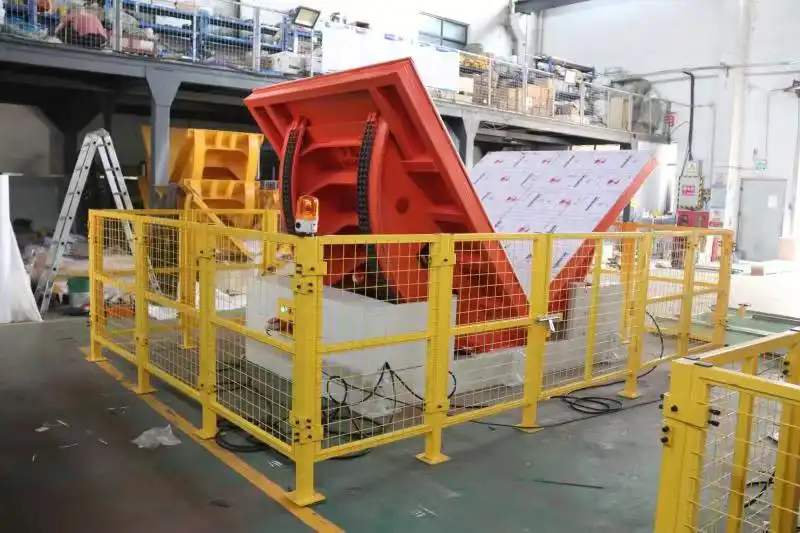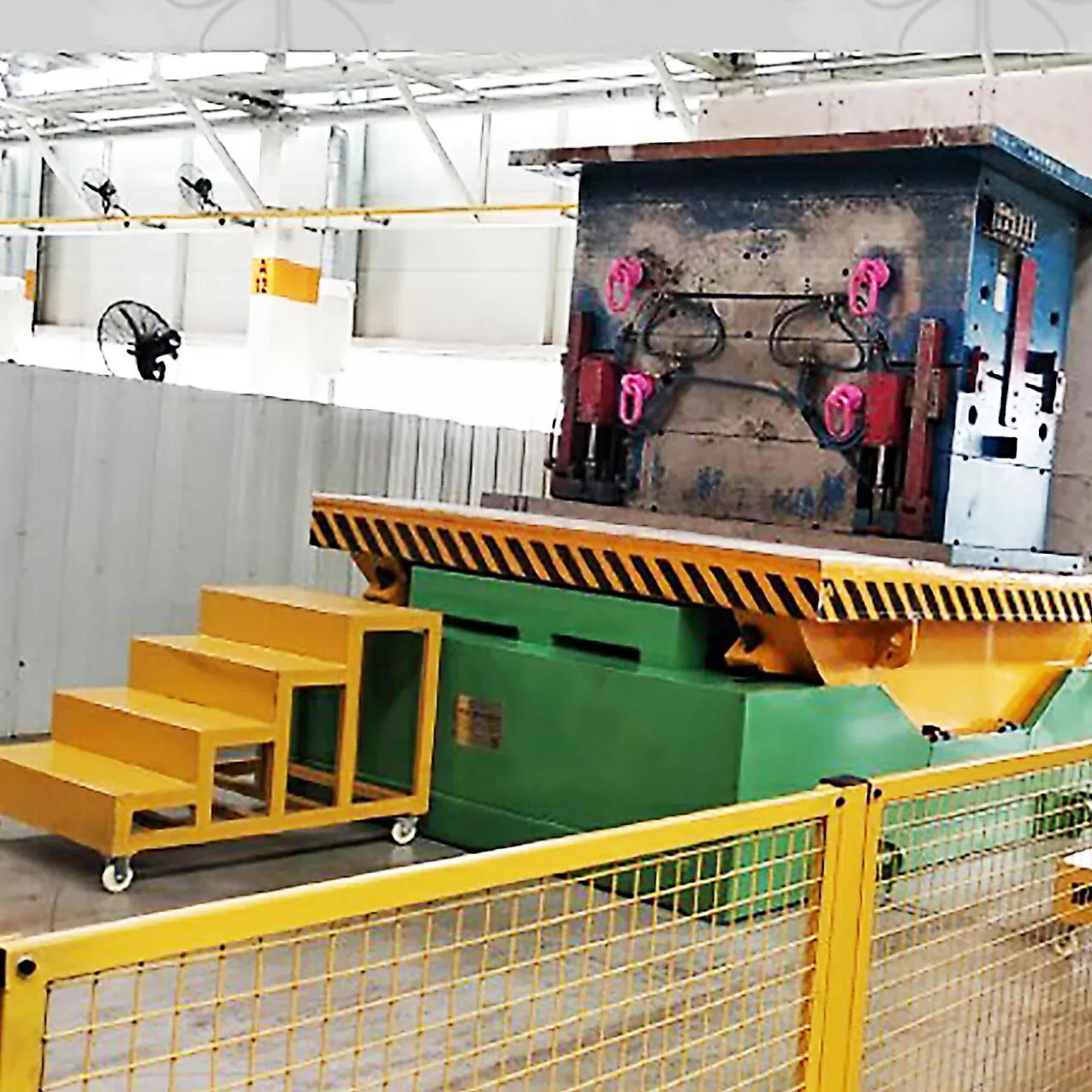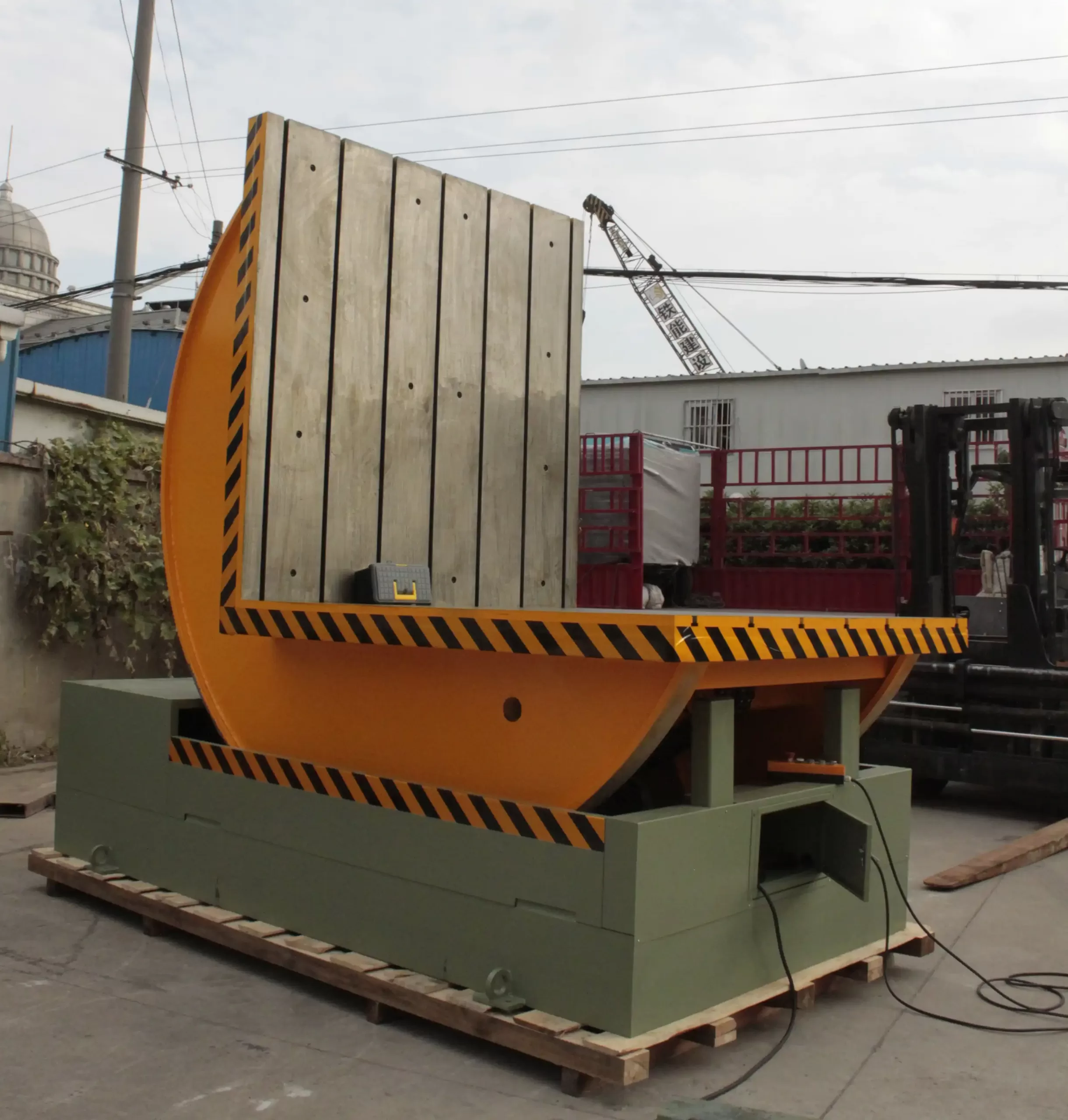What’s the ROI on a Mold Upender Investment for U.S. Tooling Shops?
Are you tired of the slow, dangerous process of flipping heavy molds and dies with cranes and chains? This common method in U.S. tooling shops is a huge bottleneck. It stops production, puts your skilled technicians at risk, and every clumsy maneuver could lead to thousands of dollars in damage to a critical mold. You're constantly worried about safety incidents, insurance claims, and the productivity hit you take every time a mold needs maintenance. This outdated process is costing you more than you think, eating into your profits and slowing down your entire operation.
A mold upender can deliver a return on investment (ROI) within 12 to 36 months for most U.S. tooling shops. This calculation is based on direct gains from increased productivity, significant reductions in labor costs, and the prevention of costly damage to molds and equipment. The ROI is further accelerated by major safety improvements, which lower insurance premiums and eliminate the financial and operational impact of workplace accidents.

I’ve spent my entire career in and around factories that handle heavy, valuable equipment. I’ve seen firsthand how a single "small" inefficiency can ripple through an entire production line, causing delays and driving up costs. Calculating the ROI on a piece of equipment like a mold upender isn't just an accounting exercise. It's about understanding the true cost of not investing. Let's break down exactly how this machine pays for itself and makes your shop safer and more profitable.
How Can a Mold Upender Directly Boost a U.S. Tooling Shop's Productivity?
Your team is ready to work on a large mold, but first, it needs to be flipped. The overhead crane operator is called over. Chains are carefully attached. The area is cleared for safety. The slow, nerve-wracking process of tilting and lowering the multi-ton piece of steel begins. This entire sequence can take 30 to 60 minutes and involves at least two or three employees. While this is happening, your expensive CNC machines and skilled technicians are idle, waiting. This is a productivity killer hidden in plain sight.
A mold upender can increase a shop's overall productivity by turning a 30-60 minute, multi-person crane operation into a safe, 5-minute, one-person task. This reclaims valuable man-hours and significantly reduces the downtime of both your personnel and your high-value production machinery, directly boosting throughput and a U.S. tooling shop's capacity for billable work.

Deconstructing the Productivity Gains
Let's move beyond the simple time-saved metric and look at the real-world impact on a shop floor. The productivity boost from a mold upender is not a single event; it's a chain reaction of efficiency improvements. When I work with clients to analyze their operations, we don't just look at the machine; we look at the entire workflow that the machine influences.
Reduced Machine and Operator Idle Time
The most obvious gain is minimizing downtime. An idle CNC machine or a waiting toolmaker is a direct financial drain. Let's quantify this. Imagine a shop rate of $150 per hour. A 45-minute delay using a crane doesn't just cost the wages of the operators involved; it represents over $112 in lost production opportunity for that one machine. If you flip molds just four times a week, that’s $448 in lost opportunity weekly, or over $23,000 a year. A mold upender reduces that 45-minute process to under 5 minutes. The new "cost" of lost opportunity becomes negligible, saving you nearly that entire amount annually.
| Metric | Using Overhead Crane | Using Mold Upender | Annual Savings/Gain |
|---|---|---|---|
| Time per Flip | 45 minutes | 5 minutes | 40 minutes saved per flip |
| Personnel Required | 2-3 operators | 1 operator | 1-2 operators freed up |
| Weekly Downtime (4 flips) | 180 minutes | 20 minutes | 160 minutes saved |
| Annual Lost Opportunity | ~$23,000 | ~$2,600 | ~$20,400 |
Enhanced Workflow and Predictability
Predictability is the foundation of an efficient operation. Crane operations are inherently unpredictable. Is the certified crane operator available? Is the area clear? Are the right chains and rigging available? These variables make scheduling difficult. A mold upender, as a dedicated piece of equipment, makes the process standardized and predictable. You can schedule maintenance with confidence, knowing the turning process will take a consistent, minimal amount of time. This allows for tighter production schedules and better capacity planning, enabling you to take on more jobs or promise shorter lead times to your U.S. customers—a significant competitive advantage. This operational smoothness is a hallmark of the top-performing shops I've helped build and improve.
What Are the Hidden Safety and Insurance Savings with a Mold Upender?
Every time a heavy mold is suspended from a crane, your entire team holds its breath. A swinging load, a slipped chain, or a moment of miscommunication can lead to a catastrophic failure. The direct costs of an accident—medical bills, equipment repairs, and OSHA fines—are immense. But the indirect costs are just as damaging: production stops for an investigation, team morale plummets, and your insurance premiums can skyrocket for years to come. You are constantly carrying this risk, and it's a heavy burden for any shop owner.
A mold upender virtually eliminates the single most dangerous maneuver in a tooling shop: flipping a heavy, off-balance load with a crane. This drastic improvement in safety can lead to a significant reduction in a U.S. shop's workers' compensation insurance premiums. By providing a stable, controlled 90-degree or 180-degree turn on a secure platform, the upender mitigates the primary cause of severe accidents, making it a powerful tool for risk management and cost control.

Quantifying the Financial Impact of Enhanced Safety
Safety is a moral imperative, but in a business context, it also has a very clear and calculable financial value. When I started my own factory, I didn't just see safety equipment as a cost; I saw it as an investment that protects my most valuable asset—my people—and my company's financial stability. Let's break down how a mold upender contributes to the bottom line through risk reduction.
Direct and Indirect Costs of Accidents
A single serious accident in a U.S. shop can be financially devastating. OSHA fines for safety violations can easily reach tens of thousands of dollars. But that's just the beginning.
- Direct Costs: Medical expenses, workers' compensation claims, and the cost to repair or replace a damaged mold or other equipment. A dropped mold can easily be a $50,000+ loss.
- Indirect Costs: These are often 4-10 times the direct costs. They include lost production time, the cost of hiring and training a replacement worker, decreased morale leading to lower productivity, and time spent on accident investigation and reporting.
A single avoided accident could, therefore, represent a saving of $100,000 or more, potentially paying for the mold upender several times over in one incident.
The Insurance Factor: EMR and Premiums
Your workers' compensation insurance premium is not a fixed cost. It's heavily influenced by your Experience Modification Rate (EMR).
- What is EMR? It's a number used by insurance companies to compare your claims history to other businesses in your industry. An EMR of 1.0 is the industry average. An EMR above 1.0 means your claims are worse than average, and you'll pay a surcharge. An EMR below 1.0 means you are safer than average, and you get a credit or discount.
- How a Mold Upender Helps: By eliminating a high-risk activity, you dramatically reduce the likelihood of severe claims. A safer record lowers your EMR. A drop in your EMR from, say, 1.2 to 0.9 can translate into a 25-30% reduction in your annual premium. For a mid-sized U.S. shop paying $150,000 annually in workers' comp, that's a saving of $37,500 to $45,000 every single year. This is a recurring return that continues for as long as you maintain that safety record.
| EMR Level | Premium Impact | Example Annual Premium (Base $150k) | Potential Annual Saving |
|---|---|---|---|
| 1.2 (High Risk) | 20% Surcharge | $180,000 | - |
| 1.0 (Average) | Neutral | $150,000 | $30,000 (from 1.2) |
| 0.9 (Low Risk) | 10% Credit | $135,000 | $45,000 (from 1.2) |
This isn't just about avoiding costs; it's about building a reputation as a safe, modern employer, which helps in attracting and retaining top talent in a competitive U.S. labor market.
How Does a Mold Upender Impact Long-Term Equipment Maintenance and Lifespan?
Using an overhead crane to flip a mold is an uncontrolled process. The mold can be set down too hard, chains can scratch or gouge precision surfaces, and the internal components can be jolted. Each of these small impacts adds up over time. You're causing micro-damage that leads to premature wear and tear. This results in more frequent, and more expensive, maintenance. Worse, it shortens the functional lifespan of a mold that may have cost hundreds of thousands of dollars, forcing a major capital re-investment sooner than planned.
A mold upender extends the life of valuable molds and dies by eliminating the shock, impact, and surface damage commonly caused by crane handling. The machine's controlled, smooth rotation on a stable platform ensures the mold is handled gently every time. This reduction in wear and tear lowers long-term maintenance costs and postpones the need for costly replacements, protecting the capital invested in a U.S. shop's most critical assets.

The Economics of Asset Preservation
In my journey from engineer to factory owner, one of the biggest lessons I learned was the difference between an expense and an investment. A mold is an investment. The way you handle it determines the return on that investment. Damaging it through improper handling is like lighting money on fire. The role of a mold upender is asset preservation, and the financial returns are very real.
Reducing Unplanned Maintenance
Unplanned downtime is a profit killer. A mold that needs unexpected repair because it was damaged during flipping disrupts the entire production schedule.
- The Crane Method: A hard landing can misalign guide pins. A dragging chain can scratch a parting line, leading to flashing on the finished parts. These issues require immediate, unscheduled toolroom intervention. The cost isn't just the repair itself, but the downstream chaos it creates: delayed customer orders, rescheduled press time, and overtime pay to catch up.
- The Upender Method: The mold is securely placed on the upender's platform, turned smoothly, and placed gently on its other side. The process is repeatable and gentle. There is no shock loading, no dragging, and no impact. This simple change drastically reduces the incidence of handling-related damage, turning unpredictable repairs into scheduled, preventative maintenance.
Extending Asset Lifespan
A large injection mold or stamping die is a major capital asset. Its value is depreciated over its expected useful life. If you can extend that life, you are getting more value from your initial investment.
| Let's look at a simple example: | Metric | Details |
|---|---|---|
| Mold Cost | $250,000 | |
| Expected Lifespan (with crane handling) | 8 years | |
| Annualized Cost | $31,250 / year | |
| Extended Lifespan (with upender handling) | 10 years | |
| New Annualized Cost | $25,000 / year | |
| Annual Value Gained | $6,250 |
By extending the life of the mold by just two years, you gain over $6,000 in value annually for that single asset. Now, multiply that by the number of high-value molds in your U.S. shop. The numbers add up very quickly. This isn't a soft benefit; it's a hard financial gain that improves your balance sheet and frees up capital for other strategic investments, like the digital transformation and efficiency upgrades that forward-thinking owners are focused on today.
What's the Payback Period for a Mold Upender in a High-Volume U.S. Shop?
You know you have a problem with your current mold handling process. It's slow, risky, and damaging your assets. But as a business owner, you have to ask the critical question: If I spend the money on a mold upender, how quickly will I get that money back? It's easy to get bogged down in complex calculations, but you need a clear, realistic timeline to justify the investment to yourself and your partners. The cost of the machine is a known quantity, but the return seems spread out and hard to pin down.
For a typical high-volume U.S. tooling shop, the payback period for a mold upender is generally between 12 and 36 months. This is calculated by adding up the annual savings from increased labor productivity, reduced equipment downtime, and lower insurance premiums, and then dividing the total cost of the upender by this annual savings figure. The payback is often even faster if a single instance of costly mold damage is prevented.

A Practical Payback Calculation
Let's create a conservative, real-world payback scenario. As an engineer, I always prefer to work with tangible numbers. We'll use the savings we've already discussed to build a simple but powerful case. The goal is to see how the investment returns its value through tangible, operational cost reductions.
Step 1: Summing the Annual Savings
We will take the key savings areas and assign conservative annual figures for a hypothetical mid-sized U.S. shop.
- Labor & Productivity Savings: We calculated this as approximately $20,400 per year by reducing idle time for machines and operators.
- Insurance Premium Reduction: By improving the safety record and lowering the EMR, a saving of $30,000 per year is very achievable for a shop with a significant premium.
- Asset Preservation (Maintenance Reduction): Let's be very conservative and say that by preventing minor damages on several molds, you save just $10,000 a year in unplanned toolroom repairs and maintenance.
Total Annual Savings: $20,400 + $30,000 + $10,000 = $60,400
Step 2: Calculating the Payback Period
Now, we need to consider the cost of the investment. A quality, appropriately sized mold upender can range in price. Let's assume a total installed cost of $90,000.
Payback Period = Total Investment Cost / Total Annual Savings
Payback Period = $90,000 / $60,400 ≈ 1.49 years
In this realistic scenario, the payback period is approximately 18 months.
| Cost/Saving Category | Annual Value |
|---|---|
| Investment Cost (One-Time) | ($90,000) |
| Labor & Productivity Saving | $20,400 |
| Insurance Premium Saving | $30,000 |
| Maintenance & Repair Saving | $10,000 |
| Total Annual Savings | $60,400 |
| Payback Period | ~18 Months |
This calculation doesn't even include the enormous financial impact of preventing a single catastrophic accident or saving a high-value mold from being destroyed—either of which could make the payback period immediate. After 18 months, that $60,400 in savings becomes pure profit, year after year, directly addressing the goal of lowering operational costs and increasing profit margins.
Beyond the Numbers: My Perspective on True ROI
When I was starting out, I saw equipment as a list of specifications and a price tag. Today, after building a business and helping countless clients, I see it differently. A machine is not just a tool; it's a part of your strategy. The true ROI of a mold upender isn't just in the numbers we calculated. It's in what those numbers enable you to do.
It’s about confidence. It’s the confidence to walk your shop floor without worrying about a crane accident. It’s the confidence to promise a customer a tight deadline because you know your workflow is predictable and efficient. It’s the confidence that your multi-million dollar investments in presses and molds are protected from careless handling.
I remember talking to a plant manager in the steel industry, a man much like Javier Morales. He was facing immense pressure on costs and his equipment was aging. He said to me, "Vincent, I can't afford any new equipment right now." I looked at his operation and replied, "With the risks you're taking and the time you're losing, you can't afford not to invest in the right equipment." We focused on one bottleneck, similar to mold handling. The solution we installed paid for itself in 16 months. But more importantly, it changed the mindset in his plant. It showed the team that the company was investing in their safety and efficiency. Productivity and morale went up across the board.
That’s the real return. It's the foundation for growth. It’s the move from being reactive—fixing things when they break—to being proactive—building a stronger, safer, and more profitable operation. That is the total solution.
Conclusion
Ultimately, a mold upender is more than a machine. It is a strategic investment in productivity, safety, and asset protection that delivers a clear and rapid return on investment.





